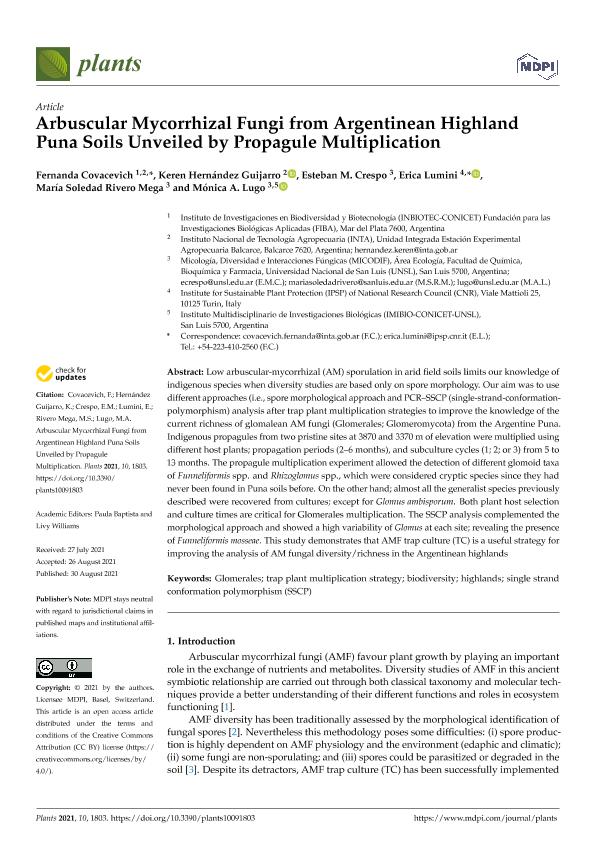Artículo
Arbuscular mycorrhizal fungi from argentinean highland puna soils unveiled by propagule multiplication
Covacevich, Fernanda ; Hernández Guijarro, Keren; Crespo, Esteban María
; Hernández Guijarro, Keren; Crespo, Esteban María ; Lumini, Erica; Rivero Mega, María Soledad; Lugo, Mónica Alejandra
; Lumini, Erica; Rivero Mega, María Soledad; Lugo, Mónica Alejandra
 ; Hernández Guijarro, Keren; Crespo, Esteban María
; Hernández Guijarro, Keren; Crespo, Esteban María ; Lumini, Erica; Rivero Mega, María Soledad; Lugo, Mónica Alejandra
; Lumini, Erica; Rivero Mega, María Soledad; Lugo, Mónica Alejandra
Fecha de publicación:
08/2021
Editorial:
MDPI
Revista:
Plants
e-ISSN:
2223-7747
Idioma:
Inglés
Tipo de recurso:
Artículo publicado
Clasificación temática:
Resumen
Low arbuscular-mycorrhizal (AM) sporulation in arid field soils limits our knowledge of indigenous species when diversity studies are based only on spore morphology. Our aim was to use different approaches (i.e., spore morphological approach and PCR–SSCP (single-strand-conformation-polymorphism) analysis after trap plant multiplication strategies to improve the knowledge of the current richness of glomalean AM fungi (Glomerales; Glomeromycota) from the Argentine Puna. Indigenous propagules from two pristine sites at 3870 and 3370 m of elevation were multiplied using different host plants; propagation periods (2–6 months), and subculture cycles (1; 2; or 3) from 5 to 13 months. The propagule multiplication experiment allowed the detection of different glomoid taxa of Funneliformis spp. and Rhizoglomus spp., which were considered cryptic species since they had never been found in Puna soils before. On the other hand; almost all the generalist species previously described were recovered from cultures; except for Glomus ambisporum. Both plant host selection and culture times are critical for Glomerales multiplication. The SSCP analysis complemented the morphological approach and showed a high variability of Glomus at each site; revealing the presence of Funneliformis mosseae. This study demonstrates that AMF trap culture (TC) is a useful strategy for improving the analysis of AM fungal diversity/richness in the Argentinean highlands.
Archivos asociados
Licencia
Identificadores
Colecciones
Articulos(INBIOTEC)
Articulos de INSTITUTO DE INV. EN BIODIVERSIDAD Y BIOTECNOLOGIA
Articulos de INSTITUTO DE INV. EN BIODIVERSIDAD Y BIOTECNOLOGIA
Citación
Covacevich, Fernanda; Hernández Guijarro, Keren; Crespo, Esteban María; Lumini, Erica; Rivero Mega, María Soledad; et al.; Arbuscular mycorrhizal fungi from argentinean highland puna soils unveiled by propagule multiplication; MDPI; Plants; 10; 1803; 8-2021; 1-14
Compartir
Altmétricas



